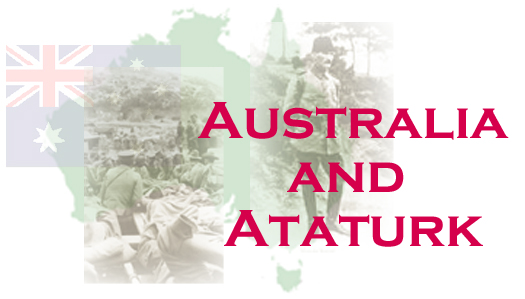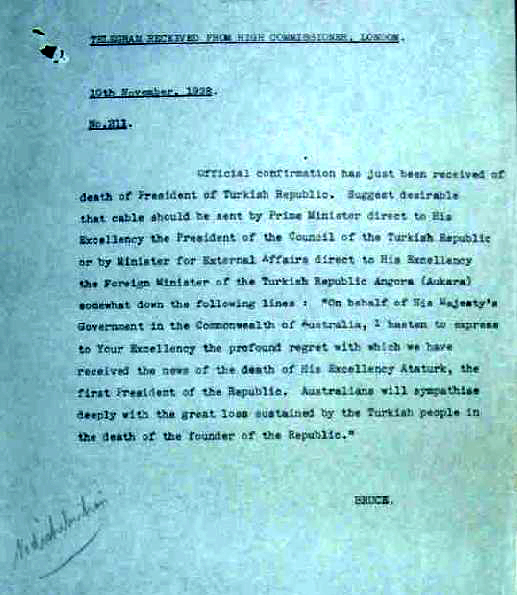 |
|
|
|
|
 By Stavros T. Stavridis |
|
|
The document shown below is from the National Archives of Australia digital collection. Stanley M.Bruce, the Australian High Commissioner in London, notified Canberra on November 10, 1938 of the death of Mustapha Kemal Ataturk. It will be noted that Bruce was Australian Prime Minister 1923-1929 and lost his Federal seat in the 1929 election. He also served as Australia’s representative to the League of Nations in Geneva during the 1930’s. Bruce represented Australia at the Imperial Conference held in London in October 1923. On his return to Australia, he visited the Gallipoli cemeteries. He arrived in Constantinople on February 6, 1924 , accompanied by Sir Fabian Ware on board the Orient Express, and was well received by the Turks. Bruce took the time to do some sightseeing around the main sites of Constantinople, such as Santa Sophia, and also dined at the British Embassy. From February 8-10, Bruce spent his time inspecting all the cemeteries at Helles, Anzac and Suvla on the Gallipoli Peninsula and “laid a wreath on the great stone of the cemetery at Anzac Beach”. Bruce persuaded the Turkish Governor of Gallipoli of “the depth of Australia’s interest in these cemeteries, and he [Bruce] is satisfied that his visit was not without important influence on the native mind in their attitude towards memorials of such hallowed interest to Australians”. For the Australian leader this visit brought back memories of 1915 where he had served with the 29th Division of the British Army. It would appear that Bruce was the first Dominion or British leader to visit the new Turkish Republic of Mustapha Kemal. Bruce arrived back in Australia in late March 1924 to resume his prime ministerial duties. It will be pointed out that Australia and the Ottoman Empire were enemies during the First World War. Gallipoli was the scene of battle with Australian and New Zealand Army Corps (Anzacs) and British forces fighting the Turks close the entrance of the Dardanelles. Both sides suffered terrible losses. It was during the Gallipoli campaign that Mustapha Kemal established his reputation as a fine military commander by rallying and leading his troops to victory over the British expeditionary force. Both the Australians and Turks respected each other fighting qualities at Gallipoli. In fact the Australians referred to their enemy as “Johnny Turk.” In conclusion it could be argued that Bruce admired Ataturk as a political and military leader.
Source: National Archives of Australia, Canberra ACT . Series A981 Tur 13 part 2 Turkey-Internal General 11 1938-1942 Stavros T Stavridis, Historian/Researcher, National Center for Hellenic Studies and Research, Latrobe University, Bundoora, Victoria, Australia |
|
|
About the Author Stavros Terry Stavridis was born in Cairo, Egypt in 1949 of Greek parents. He migrated to Australia with his parents in September 1952. Stavros has a Bachelor of Arts (B.A) in Political Science/Economic History and B.A (Hons) in European History from Deakin University and M.A in Greek/Australian History from RMIT University. His MA thesis is titled "The Greek-Turkish War 1919-23: an Australian Press Perspective." Stavros has nearly 20 years of teaching experience, lecturing at University and TAFE (Technical and Further Education, the equivalent of Community College in the US) levels. He has presented papers at international conferences in Australia and USA and has also given public lectures both in Australia and on the West Coast of the US. Many of his articles have appeared in the Greek-American press. He currently works as a historical researcher at the National Center for Hellenic Studies and Research, Latrobe University, Bundoora, Victoria, Australia. Stavros' research interests are the Asia Minor campaign and disaster, Middle Eastern history, the Assyrian and Armenian genocides, Greece in the Balkan Wars 1912-13 and the First World War and history in general. Read More About the Greeks of Asia Minor HCS maintains a permanent, extensive archives of articles which readers are invited to browse. For more information about Smyrna or Asia Minor Greeks, see the webpage located at the URL http://www.helleniccomserve.com/contents.html#Smyrna. |
|
 |
|
|
|
|
|
2000 © Hellenic Communication Service, L.L.C. All Rights Reserved. http://www.HellenicComServe.com |
